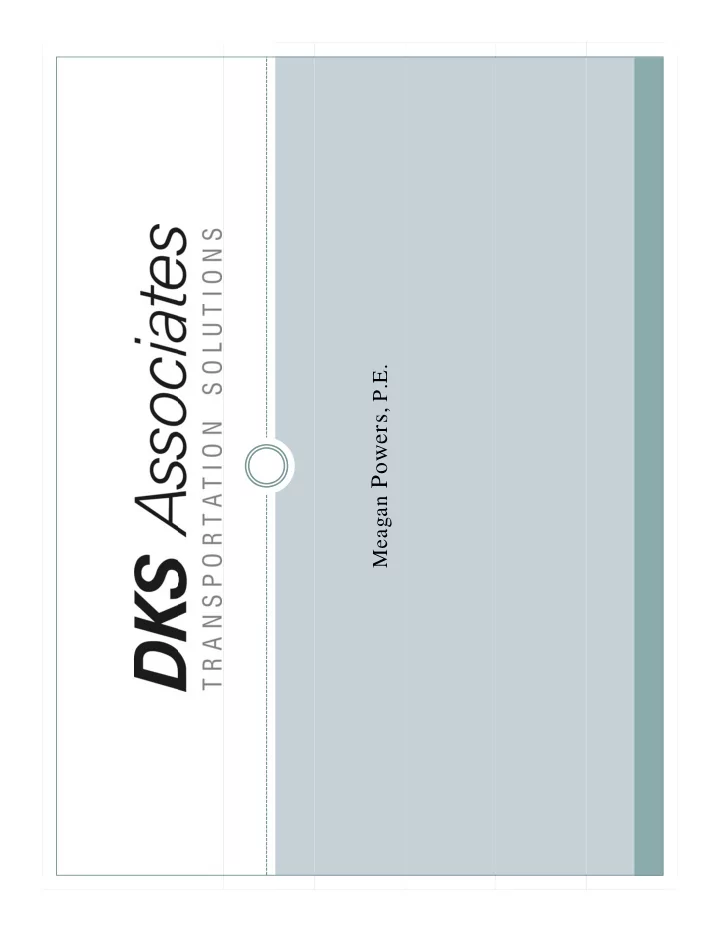

Meagan Powers , P.E.
About DKS � Specialized Transportation Firm p p � Transportation Planning & Design � ITS Design � Operational Analysis O i l A l i � Employee Owned, 150 � Eight Offices Located in Washington, Oregon, Ei ht Offi L t d i W hi t O California, Texas, and Florida
DKS Seattle � Work with Public � Transit Work Includes: Agencies Agencies • Route Studies R S di • King County Metro • Transit Treatments • Pierce Transit • Transit Signal Priority Transit Signal Priority • Sound Transit • Technology Improvements • City of Seattle • Maintenance Base M i t B • WSDOT Operations • FCC License
What is RapidRide? � King County Metro’s version g y of Bus Rapid Transit � Will add 100,000 service hours of new transit in 5 corridors � Both buses and the corridors B th b d th id in which they operate are being designed to provide being designed to provide frequent, fast, reliable transit service
RapidRide Corridor Treatments � Transit Signal Priority (TSP) g y ( ) � Transit Queue Jump � Business Access/ Transit (BAT) Lanes / ( ) � Signal Timing Optimization � Curb Extensions/ In-lane Bus Stops / p � Turn Radius Improvements
Transit Signal Priority � Gives approaching buses priority at signalized pp g p y g intersections in order to reduce the delay to transit. � Signals can either “hold” an approach in green longer, so a bus can pass through without stopping, or � Signals can truncate the red time for buses to serve Si l t t th d ti f b t the bus movement sooner
Transit Queue Jump � Requires an Exclusive Bus Lane or Right Turn Only q g y Lane � Separate signal head and phase for the bus h f th b movement
Business Access/ Transit Lanes � Dedicated Lane for Transit Use � Allows Autos to use the lane for right turns at intersections or into business driveways.
Other Operational Treatments � Optimizing Signal Timing p g g g Decrease signal delays by improving timing for major street • � Curb Extension/ In Lane Bus Stop Stopping in lane eliminates the time for buses to merge back into traffic l l h f b b k ff • � Curb Radius Improvements Reduces delay/ improves safety by facilitating the bus movement Reduces delay/ improves safety by facilitating the bus movement • •
Bus and Station Amenities � Bus � Station • Smart technology/ GPS Smart technology/ GPS • Next Bus Arrival Signs Next Bus Arrival Signs equipped to • Pay Stations on Platform communicated to the • Raised platform for ADA roadside equipment and roadside equipment and l loading di relay real-time location • Larger, lit shelters and travel time information to the stations • 3 doors for loading/ unloading passengers p g • Low floor for ADA access • Off-board pay stations (ORCA card) (ORCA card)
A-Line RapidRide � 11.5 mile corridor along SR-99 from International Blvd Light Rail Station to Federal Way Transit Center Center � Includes 33 signalized intersections in 4 jurisdictions and 5 agencies � Operational Analysis began in 2007 � RapidRide Treatments • Signal Coordination and Optimization Si l C di i d O i i i • Transit Signal Priority at 17 Intersections • HOV Lane Addition
A-Line RapidRide Design � Design began in summer 2008 and finished this fall. g g � Design elements needed to support RapidRide operations: • 11.5 Mile of fiber optic cable to support communication between the buses and the roadside equipment • Upgrading 21 signal controllers in two agencies to support TSP • Upgrading 21 signal controllers in two agencies to support TSP functionality • Installing 32 roadside antennas to enable wireless communication between the buses, signal controllers, and i ti b t th b i l t ll d stations � Construction begins January 2010. g y
Recommend
More recommend